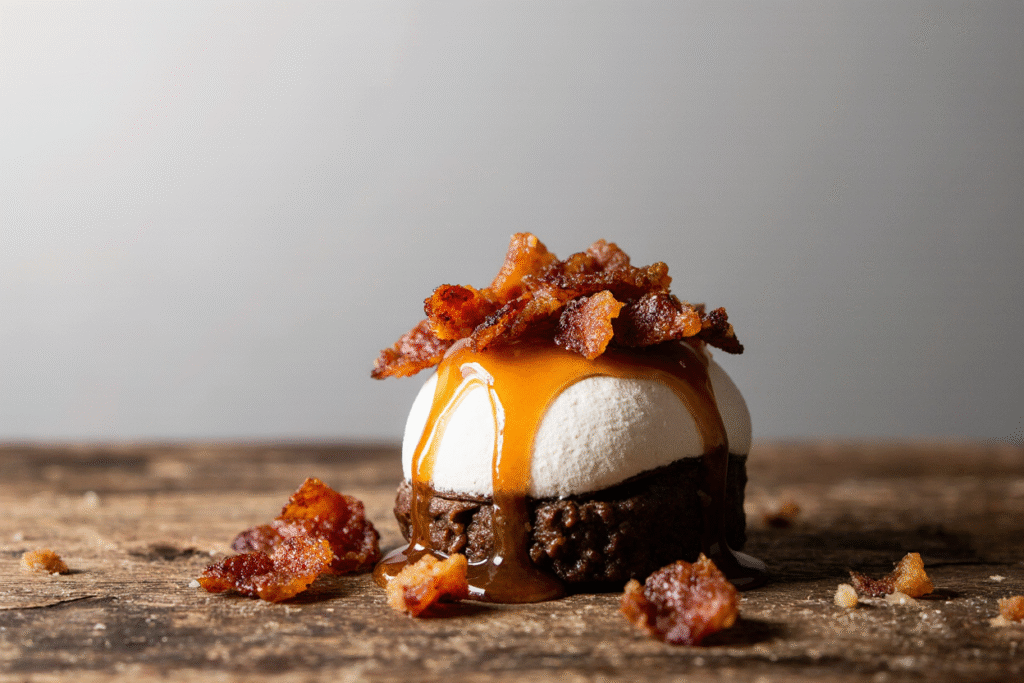Table of Contents
We take our bacon seriously around here. Bacon for breakfast, bacon for lunch, bacon for dinner – and now, bacon for dessert in the most spectacular way imaginable. This Bacon & Whiskey Caramel Marshmallow Toffee isn’t just a candy; it’s a culinary adventure that pushes the boundaries of what toffee can be. Every bite delivers layers of complexity that unfold on your palate like a perfectly orchestrated symphony of sweet, salty, smoky, and boozy notes.
What makes this toffee extraordinary isn’t just the unexpected combination of ingredients – it’s how they work together to create something greater than the sum of their parts. The crispy bacon provides textural contrast and smoky depth, while whiskey adds sophisticated warmth that elevates the entire experience. Marshmallows contribute pillowy softness that balances the hard candy crunch, creating a multi-dimensional treat that keeps you coming back for more.

This recipe represents the evolution of modern confectionery, where traditional techniques meet bold flavor innovations. It’s the perfect example of how classic toffee-making methods can be transformed into something completely contemporary while still honoring the fundamental principles that make great candy. Whether you’re an experienced candy maker or someone who’s never attempted homemade confections, this recipe delivers professional-quality results that will amaze everyone who tries it.
The Art of Combining Sweet and Savory
The marriage of bacon and caramel might seem unconventional to some, but it’s actually a match made in culinary heaven. Bacon’s saltiness enhances the sweetness of caramel through contrast, while its smoky, umami-rich flavors add complexity that transforms ordinary caramel into something extraordinary. This isn’t just about adding bacon for novelty – it’s about creating genuine flavor harmony.
The key to success lies in selecting the right bacon and preparing it properly. Thick-cut bacon works best because it maintains better texture when incorporated into toffee. Cook it until crispy but not overly brittle – you want pieces that hold up structurally while still providing that satisfying crunch. Pat the cooked bacon thoroughly dry to remove excess grease that could interfere with proper toffee setting.
Timing matters when incorporating bacon into toffee. Add it too early, and the bacon becomes soggy from steam and moisture. Add it too late, and it won’t adhere properly to the candy base. The sweet spot is during the final stages of cooking, when the toffee is nearly ready but still hot enough to embrace the bacon pieces completely.
Whiskey Selection and Integration Techniques
Not all whiskeys work equally well in confectionery applications. The harsh bite of some spirits can overpower delicate caramel flavors, while others might disappear entirely when heated. Medium-bodied whiskeys with smooth, mellow profiles work best – think bourbon or Irish whiskey rather than peated Scotch or high-proof varieties.
The alcohol content requires careful consideration since some will evaporate during cooking while the remainder concentrates and intensifies. Start with less than you think you need – you can always add more, but removing excess alcohol flavor is impossible once it’s incorporated. A general rule is that about 30% of the alcohol will remain after cooking, so plan accordingly.
Temperature control becomes crucial when adding whiskey to hot caramel. Add it off the heat to prevent dangerous flare-ups, then return to gentle cooking to integrate properly. The mixture will bubble vigorously when the whiskey hits the hot caramel – this is normal and expected. Stir constantly during this phase to ensure even distribution and prevent scorching.
Marshmallow Magic: Creating Perfect Texture Contrast
Incorporating marshmallows into toffee requires understanding how they behave under heat. Regular marshmallows will completely melt and disappear, so timing and technique are everything. The goal is partial melting that creates pockets of chewy sweetness throughout the hard toffee matrix.
Mini marshmallows work better than large ones because they distribute more evenly and melt at more predictable rates. Add them during the final minute of cooking, stirring just enough to incorporate but not so much that they completely dissolve. Some pieces should remain visible and maintain their shape while others create swirls of marshmallow throughout the toffee.
The contrast between hard toffee and soft marshmallow creates textural interest that keeps each bite engaging. This technique also adds visual appeal – the white marshmallow against golden toffee and dark bacon creates an attractive confection that looks as good as it tastes.
Mastering Temperature and Timing
Successful toffee making depends entirely on understanding temperature stages and timing. This isn’t a recipe where you can wing it – candy making requires precision and attention to detail. A reliable candy thermometer is absolutely essential, though experienced candy makers can also judge doneness by visual and auditory cues.
The hard crack stage (300-310°F) is your target for the base toffee. At this temperature, the sugar syrup will form hard, brittle threads when dropped into cold water. Undercooking results in chewy toffee that sticks to teeth, while overcooking creates bitter flavors and can cause the mixture to separate.

Watch for color changes as much as temperature readings. Properly cooked toffee develops a rich, amber color that indicates proper caramelization. The mixture should smell nutty and complex, not burnt or acrid. If you detect any burning smells, remove from heat immediately – burned sugar can’t be salvaged.
Equipment Essentials for Professional Results
The right equipment makes toffee making significantly easier and more reliable. A heavy-bottomed saucepan distributes heat evenly and prevents hot spots that can cause scorching. Stainless steel or enameled cast iron work best – avoid nonstick coatings that can break down at high temperatures.
A wooden spoon or heat-resistant silicone spatula handles the stirring duties without conducting heat back to your hand. Metal spoons become dangerously hot and can scratch pan surfaces. Keep stirring implements clean and dry – even small amounts of moisture can cause sugar to crystallize.
Prepare your workspace before starting cooking. Have parchment paper ready, bacon cooked and chopped, marshmallows measured, and whiskey at room temperature. Once the cooking process begins, things move quickly, and there’s no time to hunt for ingredients or equipment.
The Science Behind Perfect Caramelization
Understanding what happens during caramelization helps you achieve consistent results. As sugar heats, it undergoes complex chemical reactions that create hundreds of flavor compounds. These reactions are temperature-dependent and irreversible – once sugar reaches certain stages, it can’t go backward.
The Maillard reaction between proteins and sugars also contributes to flavor development, especially when bacon is involved. The amino acids in bacon interact with the sugar to create additional flavor compounds that wouldn’t exist in either ingredient alone. This is why bacon-caramel combinations taste so much more complex than simple additions would suggest.
Crystallization is the enemy of smooth toffee. Even tiny amounts of undissolved sugar can trigger chain reactions that turn smooth caramel into grainy disappointment. Brush down pan sides with wet pastry brush to dissolve sugar crystals, and avoid stirring once the mixture begins boiling unless absolutely necessary.
Presentation and Storage Techniques
Proper cooling and cutting techniques ensure professional-looking results. Pour the hot toffee onto parchment-lined baking sheets, spreading to desired thickness. Work quickly but carefully – the mixture is extremely hot and can cause severe burns. Allow complete cooling before attempting to cut or break into pieces.
Sharp, clean knives work best for cutting toffee into uniform pieces. Score the surface while still slightly warm, then complete cuts once fully cooled. For rustic presentation, break cooled toffee into irregular shards using clean hands or the handle of a heavy knife.
Store finished toffee in airtight containers with parchment paper between layers. Properly made toffee keeps for weeks at room temperature, though humidity can affect texture. For longer storage, freeze individual pieces wrapped in wax paper.
Troubleshooting Common Issues
Grainy toffee usually results from crystallization during cooking. Prevention is better than cure – keep equipment scrupulously clean, avoid stirring unnecessarily, and brush down pan sides regularly. If crystallization begins, adding a small amount of corn syrup can sometimes save the batch.
Separated toffee occurs when fat separates from sugar during cooking. This often happens with temperature fluctuations or when ingredients are added too quickly. Vigorous whisking off the heat sometimes brings separated mixtures back together.
Soft toffee that doesn’t harden properly indicates undercooking. Unfortunately, there’s no fix once the toffee has cooled – temperature accuracy is crucial for proper texture development.
This Bacon & Whiskey Caramel Marshmallow Toffee represents the adventurous spirit of modern confectionery while honoring traditional candy-making techniques. The result is a sophisticated treat that surprises and delights with every bite, proving that the best innovations often come from unexpected combinations executed with skill and precision.



